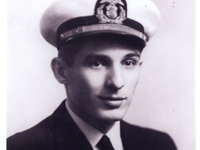|
"The coastline voyages were unescorted by any Navy vessels or even airplanes, and they
were easy prey for the submarines, and many ships were sunk along the coast." (Audio
Interview, 19:13)
|
|
{
align: 'left'
}
|
William S. Chambers |

William Chambers, Philadelphia, Pennsylvania [1943] | World War, 1939-1945
Merchant Marine
Atlantic, Mediterranean, and Pacific Theaters
Ship's Master
PA
 |
|
 |
William Chambers was en route to Hawaii on a cargo ship on December 7, 1941, when
his captain announced news of the attack on Pearl Harbor. Chambers had been in effect
training for war for two years. At 18, he entered the Pennsylvania State Nautical School
in October 1939, shortly after WWII broke out in Europe, and the school had its students
learn the ropes on different vessels of the U.S. Navy. During the war, Chambers made
many dangerous voyages, none worse than a 1942 trip to the Soviet Union on which he
lost three ships to torpedoes or mines. At war’s end, he was still at sea, carrying supplies
for the invasion of Japan which were never needed.
|
|

